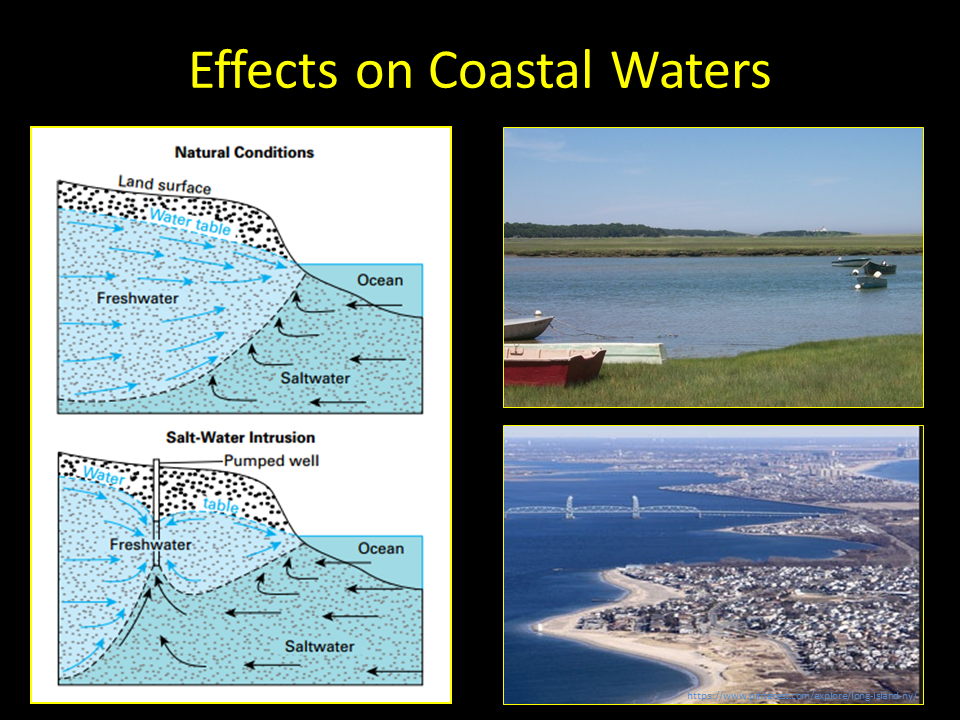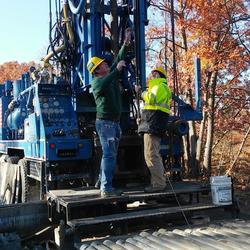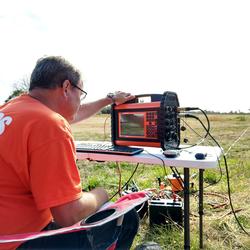Sea Level Rise and the Marshall Islands
How sea level affects the island, including saltwater intrusion
Saltwater intrusion has occurred to some degree in many of the coastal aquifers of the United States. Since saltwater cannot be used to irrigate crops or be consumed by people, saltwater intrusion can be very problematic to coastal communities that rely on fresh groundwater supplies for the livelihood. The USGS studies how excessive groundwater pumping, sea level rise, and other factors contribute to the encroachment of seawater into fresh groundwater supplies. This research aids those who manage the water supplies, allowing for better management strategies to protect people and their sources of water.
BACKGROUND
Under natural conditions, the seaward movement of freshwater prevents saltwater from encroaching on freshwater coastal aquifers. This interface between freshwater and saltwater is maintained near the coast or far below the land surface. The interface actually is a diffuse zone where freshwater and saltwater mix. This zone is referred to as the zone of dispersion or the zone of transition.
Groundwater pumping can reduce freshwater flow toward coastal areas and cause saltwater to be drawn toward the freshwater zones of the aquifer. Saltwater intrusion decreases freshwater storage in the aquifers, and, in extreme cases, can result in the abandonment of wells. Saltwater intrusion occurs by many ways, including lateral encroachment from coastal waters and vertical movement of saltwater near discharging wells. The intrusion of saltwater caused by withdrawals of freshwater from the groundwater system can make the resource unsuitable for use. Thus, groundwater management plans should take into account potential changes in water quality that might occur because of saltwater intrusion.

WHERE HAVE WE SEEN IT HAPPEN?
One part of the U.S. that has dealt with saltwater intrusion is Florida. In Florida, saltwater has intruded into groundwater supplies through different compounding ways. For example, saltwater has encroached into aquifers because fresh groundwater levels have decreased relative to sea level, allowing higher gradient water to flow toward the freshwater. Also, leaking saltwater inland canals, leakage between aquifers, or even upwelling of saltwater from depth also have impacted freshwater aquifers. Water managers in Florida are using information from local, State, Tribal, and Federal saltwater-intrusion monitoring networks, such as from the USGS, to prevent and reverse saltwater intrusion.
RELATED USGS RESEARCH
The USGS studies and monitors freshwater/saltwater interfaces in coastal communities to help protect against saltwater intrusion. Here are a few links to demonstrate how the USGS does studies along each coast.
- Freshwater-Saltwater Interactions along the Atlantic Coast
- Saltwater intrusion monitoring in Florida
- Seawater Intrusion in California
- Water Science School - Groundwater Depletion
ADDITIONAL RESOURCES
U.S. Environmental Protection Agency (EPA)
National Ocean and Atmospheric Administration (NOAA)
Here area a few USGS websites highlighting saltwater intrusion studies.
Groundwater Sustainability of the Long Island Aquifer System
Saltwater-Interface Mapping - Long Island, New York
Envisioning processes beneath the ground surface can be hard. Here's a few illustrations to help visualize the concept of saltwater intrusion.
Most coastal communities have, or will have, to deal with potential saltwater intrusion if they overwithdraw groundwater wells. Here are a few recent studies that demonstrate the science behind exploring the freshwater/saltwater interface.
Saltwater intrusion in the Floridan aquifer system near downtown Brunswick, Georgia, 1957–2015 Saltwater intrusion in the Floridan aquifer system near downtown Brunswick, Georgia, 1957–2015
Saltwater intrusion monitoring in Florida Saltwater intrusion monitoring in Florida
Saltwater intrusion in the surficial aquifer system of the Big Cypress Basin, southwest Florida, and a proposed plan for improved salinity monitoring Saltwater intrusion in the surficial aquifer system of the Big Cypress Basin, southwest Florida, and a proposed plan for improved salinity monitoring
Current challenges using models to forecast seawater intrusion: lessons from the Eastern Shore of Virginia, USA Current challenges using models to forecast seawater intrusion: lessons from the Eastern Shore of Virginia, USA
Ground water in freshwater-saltwater environments of the Atlantic Coast Ground water in freshwater-saltwater environments of the Atlantic Coast
Here are examples of news stories about USGS saltwater intrusion studies.
Saltwater intrusion has occurred to some degree in many of the coastal aquifers of the United States. Since saltwater cannot be used to irrigate crops or be consumed by people, saltwater intrusion can be very problematic to coastal communities that rely on fresh groundwater supplies for the livelihood. The USGS studies how excessive groundwater pumping, sea level rise, and other factors contribute to the encroachment of seawater into fresh groundwater supplies. This research aids those who manage the water supplies, allowing for better management strategies to protect people and their sources of water.
BACKGROUND
Under natural conditions, the seaward movement of freshwater prevents saltwater from encroaching on freshwater coastal aquifers. This interface between freshwater and saltwater is maintained near the coast or far below the land surface. The interface actually is a diffuse zone where freshwater and saltwater mix. This zone is referred to as the zone of dispersion or the zone of transition.
Groundwater pumping can reduce freshwater flow toward coastal areas and cause saltwater to be drawn toward the freshwater zones of the aquifer. Saltwater intrusion decreases freshwater storage in the aquifers, and, in extreme cases, can result in the abandonment of wells. Saltwater intrusion occurs by many ways, including lateral encroachment from coastal waters and vertical movement of saltwater near discharging wells. The intrusion of saltwater caused by withdrawals of freshwater from the groundwater system can make the resource unsuitable for use. Thus, groundwater management plans should take into account potential changes in water quality that might occur because of saltwater intrusion.

WHERE HAVE WE SEEN IT HAPPEN?
One part of the U.S. that has dealt with saltwater intrusion is Florida. In Florida, saltwater has intruded into groundwater supplies through different compounding ways. For example, saltwater has encroached into aquifers because fresh groundwater levels have decreased relative to sea level, allowing higher gradient water to flow toward the freshwater. Also, leaking saltwater inland canals, leakage between aquifers, or even upwelling of saltwater from depth also have impacted freshwater aquifers. Water managers in Florida are using information from local, State, Tribal, and Federal saltwater-intrusion monitoring networks, such as from the USGS, to prevent and reverse saltwater intrusion.
RELATED USGS RESEARCH
The USGS studies and monitors freshwater/saltwater interfaces in coastal communities to help protect against saltwater intrusion. Here are a few links to demonstrate how the USGS does studies along each coast.
- Freshwater-Saltwater Interactions along the Atlantic Coast
- Saltwater intrusion monitoring in Florida
- Seawater Intrusion in California
- Water Science School - Groundwater Depletion
ADDITIONAL RESOURCES
U.S. Environmental Protection Agency (EPA)
National Ocean and Atmospheric Administration (NOAA)
Here area a few USGS websites highlighting saltwater intrusion studies.
Groundwater Sustainability of the Long Island Aquifer System
Saltwater-Interface Mapping - Long Island, New York
Envisioning processes beneath the ground surface can be hard. Here's a few illustrations to help visualize the concept of saltwater intrusion.
Most coastal communities have, or will have, to deal with potential saltwater intrusion if they overwithdraw groundwater wells. Here are a few recent studies that demonstrate the science behind exploring the freshwater/saltwater interface.
Saltwater intrusion in the Floridan aquifer system near downtown Brunswick, Georgia, 1957–2015 Saltwater intrusion in the Floridan aquifer system near downtown Brunswick, Georgia, 1957–2015
Saltwater intrusion monitoring in Florida Saltwater intrusion monitoring in Florida
Saltwater intrusion in the surficial aquifer system of the Big Cypress Basin, southwest Florida, and a proposed plan for improved salinity monitoring Saltwater intrusion in the surficial aquifer system of the Big Cypress Basin, southwest Florida, and a proposed plan for improved salinity monitoring
Current challenges using models to forecast seawater intrusion: lessons from the Eastern Shore of Virginia, USA Current challenges using models to forecast seawater intrusion: lessons from the Eastern Shore of Virginia, USA
Ground water in freshwater-saltwater environments of the Atlantic Coast Ground water in freshwater-saltwater environments of the Atlantic Coast
Here are examples of news stories about USGS saltwater intrusion studies.



